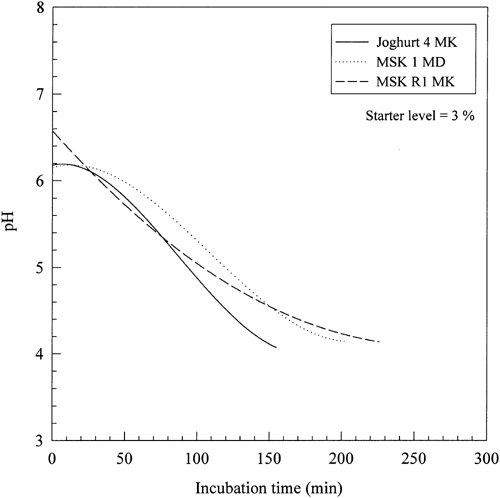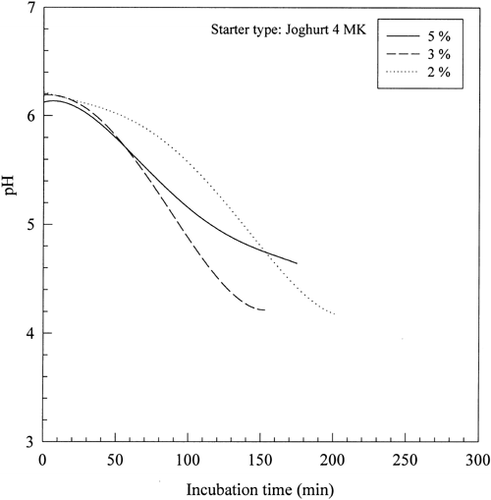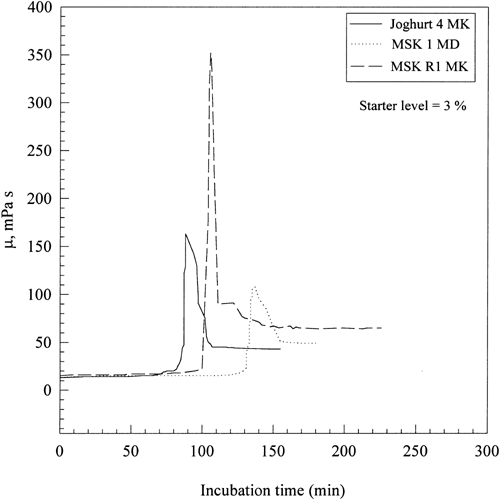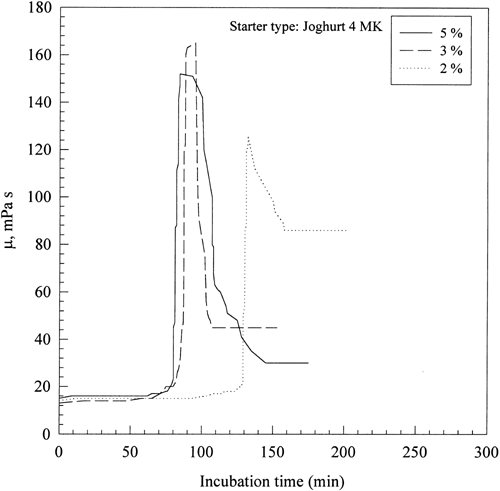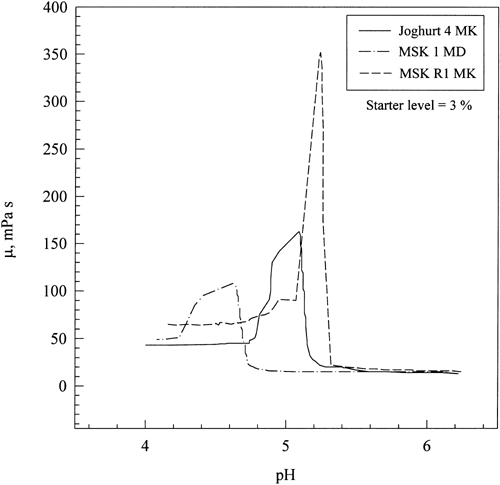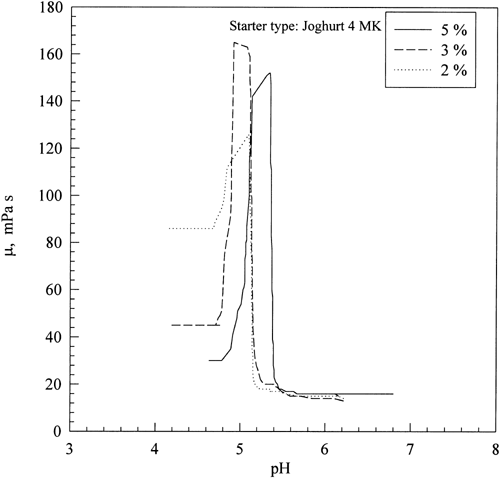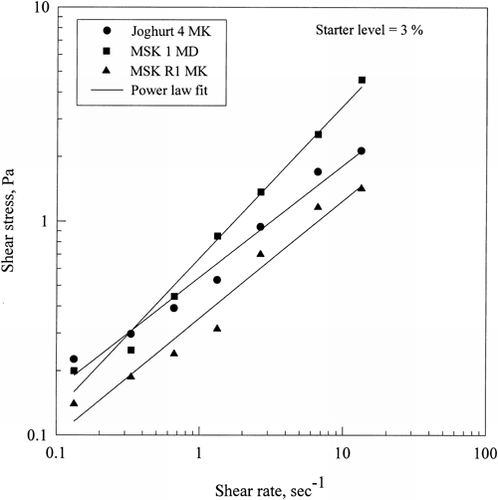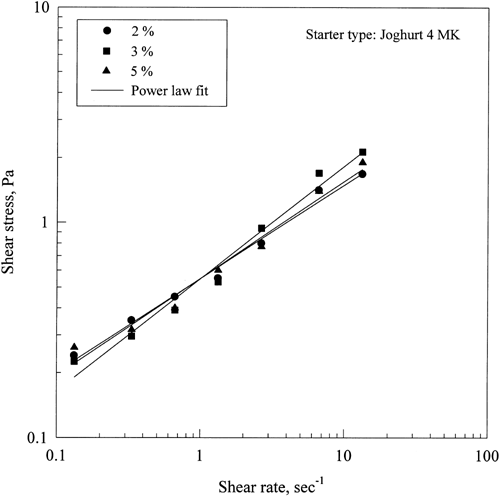Abstract
The effect of type and level (2, 3, 5%) of starter cultures on the rheological properties of set yogurt during gelation process was studied using a cylindrical rotational viscometer. At the beginning of the gelation process the viscosity was constant after which the viscosity rose rapidly and reached a maximum value and then gradually decreased. The results indicate that the starter type and level have a definite effect on yogurt viscosity during gelation process. The Ostwald-de Waele power-law model was used to characterize the flow behavior of the curd.
INTRODUCTION
Lactic acid is the characteristic substance in all fermented dairy products like yogurt and it is generated by all starter microorganisms. Acid gelation of milk is very important in the manufacture of set yogurt Citation[1]. Information is needed on the physical changes occurring in the milk during acidification to develop optimum processing procedure for yogurt. Upon increasing the acidity by the activity of starter cultures, colloidal calcium phosphate is solubilized from casein micelles, micellar disintegration takes place and the caeins associate to form a network in the form of a coagulum or gel Citation[2]. However, the rate of acidification that depends on the amount and type of starter culture affects this sequence and determines the rheological characteristics of the casein matrix. Slow acidification leads to the gel network formation with good hydration capacity Citation[2]. Rapid acidification results in aggregation and precipitation of casein and syneresis occurs Citation[3].
The rheological properties of coagulum network in yogurt vary, depending upon milk composition Citation[4], dry matter content Citation5-6 and heat treatment of milk Citation7-10. In addition, these characteristics are influenced by strains of starter cultures used Citation11-15 and incubation temperature Citation16-17.
In order to monitor changes in viscosity and the nature of curd formation during gelation process, viscometer is a useful technique to study the viscosity of yogurt during acid coagulation because of its ability to measure the continuous changes in viscosity of the milk during processing of yogurt. Such measurements are sensitive to the initial stage of casein micelles aggregation and demonstrate that coagulation starts well before any visual observation of gelation. A point is reached during aggregation in which a three dimension cross-linked network of casein is formed and this coagulation can be observed rheologically Citation[18].
A number of studies of the fundamental rheological properties of milk protein have been conducted to determine the milk gelation process using dynamic viscoelastic methods Citation19-21. Among these studies, nothing has been published about the flow behavior and steady shear rheological models which are useful in the design of unit processes. The objectives of this research were to display the influence of different types and various levels of starter cultures on the rheological characteristics of set yogurt during gelation process.
MATERIALS AND METHODS
Starter Supply and Propagation
For the study of the starter culture type, three types of commercial yogurt starter cultures were obtained from Laboratorium Wisby Tonder ApS, Denmark. These types were:
| • | Joghurt 4 MK, undefined multiple-species culture, (combined streptococcus salivarius sub. thermophilus and lactobacillus delbrukii sub. bulgaricus). | ||||
| • | MSK 1 MD, defined multiple-species culture, (combined streptococcus salivarius sub. thermophilus and lactobacillus acidophilus). | ||||
| • | MSK R1 MK, undefined multiple-species culture, (combined streptococcus salivarius sub. thermophilus, lactobacillus delbrukii sub. bulgaricus and lactobacillus acidophilus). All experiments were done at 3% starter level. | ||||
Milk Sample Preparation
Bulk raw milk was heated to 60°C and separated into cream and skim milk using a separator (Westfalia separator, Hamburg, Germany). Standardized milk with 3% fat was prepared and immediately heated at 137°C for two seconds using plate heat exchanger (Stritherm indirect heater, type P13, Alfa Laval, Food and Dairy International AB, Lund, Sweden) with in-line homogenizer. The heated milk was homogenized at 2000 psi, cooled to 4°C and then packed in 1L container.
Rheological Measurements
The rheological measurements during the coagulation process were conducted continuously with a digital conventional rotational viscometer (Cannon Instrument Co., LV 2000, State College, PA, USA) Searle type, with a fixed outer cylinder and a rotating measuring bob. The radius of the rotating cylinder was 0.9421 cm, length 7.493 cm and the outer cylinder was a container with a 4.0 cm radius. All experiments were made with 450 ml of milk in a specially designed glass beaker recommended by the viscometer manufacturer. The coagulation temperature was kept at 45°C throughout the process by means of a thermostatically controlled water bath with a temperature accuracy of ± 0.05°C. Viscosity measurements were conducted at a constant rotational speed of 60 rpm. At the time of monitoring, standardized milk was tempered to 45°C in a thermostatically controlled water bath and then inoculated with the required type and level of starter.
The pH of the milk during the coagulation process was measured continuously by immersing the glass electrode of the pH meter (Hanna Instruments, H19020 microprocessor bench pH meter, Woonsocket, RI, USA) in the milk. The pH meter was standardized with buffers at 45°C before use.
RESULTS AND DISCUSSION
Starter Activity and Acid Development
Acid development during gelation process for all experiments shown in Figures and were typical showing a rapid increase in acid production corresponding to the logarithmic phase of growth, which tapered off as level of acidity became limiting Citation[22]. This was expected since the same process conditions were in all treatments.
Viscosity-Incubation Time Profiles
The measured viscosity-incubation time profiles are shown in Figures and . These profiles can be separated into three stages corresponding to different viscosity behavior:
An induction period without any significant changes in viscosity: This stage begins after addition of the starter culture and concludes when the first aggregation causes a step increase in the viscosity. The changes in viscosity were not noticed for the initial period where the casein micelles appeared to be uniform in size and distribution Citation[23].
A flocculation stage with maximum increase in viscosity: The sharp increase in viscosity was likely as the result of aggregation reactions, a totally different structure was evident, consisting of large casein aggregates of nonspecific shape and dimensions Citation24-25.
A decrease in viscosity may be due to contraction with rearrangement of casein micelles and syneresis of the gel. The gradual decrease in viscosity in this stage can also be attributed to the changes in the microstructure of the yogurt curd which became finer and more porous, exhibiting a more continuous casein network composed of smaller particles linked into a three-dimensional network via particle chains Citation[23], Citation[26].
The effect of starter type on viscosity-incubation time curves is presented in Figure . The highest viscosity was displayed by using MSK R1 MK starter, followed by Joghurt 4 MK and MSK 1 MD starters. These results indicate that the starter type has a definite effect on yogurt viscosity during coagulation process. The mechanism of starter action, however, is not understood clearly, even if the effect could be explained readily by the different properties of the gel, different concentrations of polysaccharides and different binding between polysaccharides and proteins Citation[27].
Taggatz and Morris Citation[28] suggested that the interactions of polysaccharides and proteins require more force to break and exhibit higher viscosity. The relationship between polysaccharides and viscosity is quite clear and the highest polysaccharides production correspond to the highest viscosity Citation[11].
Values of pH have a considerable influence on the structure of the coagulum formed by milk proteins. However, when the viscosity readings are compared with the pH values during gelation process (Figure ), it is obvious that primarily secreted materials like polysaccharides affected the observed viscosities. These observations support the results presented in Figure . Many reports indicate that the use of starter cultures, producing different polysaccharides, in yogurt manufacture results in a product with increased viscosity Citation29-30.
The effect of starter level on viscosity-incubation time curve is presented in Figure . As starter level was increased from 2% to 3 and 5%, the peak viscosity at 2% starter was lower than at 3 or 5% while the onset of the gelation time was reduced. As would be expected, the higher the starter inoculum used, the higher the activity during gelation process. The shape of the viscosity- pH profiles (Figure ) shows similar trend to the viscosity incubation time profile discussed above.
Rheological Characterization
To quantify the rheological behavior of the yogurt curd during gelation process under the effect of the starter type and level independently of time, the flow curves at the maximum value of viscosity were measured (Figures and ). The shear rates were switched at maximum viscosity time every 20 seconds. In all of the rheological characterizations the curd behaved as a shear-thinning material where the apparent viscosity decreases as the shear rate increases. The Ostwald-de Waele power law model can be used to express this non-Newtonian characteristic:
Regression analysis resulting in values of n and m showed correlation coefficients around 0.97. The values of n and m for the effect of the starter type and level are summarized in Tables and , respectively. The flow curves (Figures and ) show good agreement between theoretical and experimental results and thus validated the proposed theoretical model.
Table 1. Effect of Starter Type on Flow Parameters
Table 2. Effect of Starter Level on Flow Parameters
The flow behavior index of the yogurt curd varies from 0.451 to 0.713. This shear-thinning behavior (i.e., n < 1) is due to the fact that the curd during coagulation process is influenced by hydrogen, electrostatic and hydrophobic interactions which hold the gel matrix together Citation[31]. Most of these forces are weak and can be broken down at energy input rates of flow shear. The highest value of the flow behavior index was displayed by using MSK 1 MD starter, followed by MSK R1 MK and Joghurt 4 MK, respectively. On the other hand the starter level showed no definite effect on the value of n. The consistency coefficient (m) of the yogurt curd differs slightly with the starter type, whereas the starter level showed no influence on the value of m.
CONCLUSIONS
The type and level of starter culture affected the rheological nature of yogurt curd during gelation. Viscosity against incubation time during the coagulation process can be separated into three stages corresponding to different viscosity behavior. The behavior of the curd showed a non-Newtonian nature and the power law model was used to quantify the flow behavior index and the consistency coefficient.
Acknowledgments
REFERENCES
- Schmidt , R. H. and Morris , H. A. 1984 . Gelation Properties of Milk Proteins, Soy Proteins, and Blended Proteins Systems . Journal of Food Technology , 38 : 85
- Heertje , I. , Visser , J. and Smits , P. 1985 . Structure Formation in Acid Milk Gels . Food Microstructure , 4 : 267
- Jablonka , M. S. and Munro , P. A. 1985 . Particle Size Distribution and Calcium Content of Batch-Precipitated Acid Casein Curd: Effect of Precipitation Temperature and pH . Journal of Dairy Research , 52 : 419
- Cobos , A. , Horne , D. S. and Muir , D. D. 1995 . Rheological Properties of Acid Milk Gels. 1. Effect of Composition, Process and Acidification Conditions on Products from Recombined Milks . Milchwissenschaft , 50 : 444
- Rohm , H. 1993 . Influence of Dry Matter Fortification on Flow Properties of Yogurt. 2. Time-Dependent Behavior . Milchwissenschaft , 48 : 614
- Skriver , A. , Roemer , H. and Quist , K. B. 1993 . Rheological Characterization of Stirred Yogurt: Viscometry . Journal Texture Studies , 24 : 185
- Kaytanli , M. 1993 . Effect of the Different Heat Treatment on the Rheological and Organoleptical Properties of Yogurt . J. Dairy Foods Home Science , 12 : 8
- Parnell-Clunies , E. M. , Kakuda , Y. , Mullen , K. and DeMan , J. M. 1986 . Influence of Heat Treatment of Milk on the Flow Properties of Yogurt . Journal of Food Science , 51 : 1459
- Velez-Ruiz , J. F. and Barbosa Canovas , G. V. 1997 . Rheological Properties of Selected Dairy Products . Critical Review in Food Science and Nutrition , 37 : 311
- Shaker , R. R. , Jumah , R. Y. and Abu-Jdayil , B. 2000 . Rheological Properties of Plain Yogurt During Coagulation Process: Impact of Fat Content and Preheat Treatment of Milk . Journal of Food Engineering , 44 : 175
- Bouzar , F. , Cerning , J. and Desmazeaud , M. 1997 . Exopolysaccharide Production and Texture-Promotion Abilities of Mixed Strain Starter Cultures in Yogurt Production . Journal of Dairy Science , 80 : 2310
- Hess , S. J. , Roberts , R. F. and Ziegler , G. R. 1997 . Rheological Properties of Non-fat Yogurt Stabilized using Lactobacillus Delbrueckii ssp. Bulgaricus Producing Exopolysaccharide or using Commercial Stabilizer Systems . Journal of Dairy Science , 80 : 252
- Kneifel , W. , Ulberth , F. , Erhard , F. and Jaros , D. 1992 . Aroma Profiles and Sensory Properties of Yogurt and Yogurt-Related Products. 1. Screening of Commercially Available Starter Cultures . Milchwissenschaft , 47 : 362
- Rawson , H. L. and Marschall , V. M. 1997 . Effect of Ropy Strains of Lactobacillus Delbrueckii ssp. Bulgaricus and Streptococcus Thermophilus on Rheology of Stirred Yogurt . International Journal of Food Science and Technology , 32 : 213
- Rohm , H. and Kovac , A. 1995 . Effect of Starter Cultures on Small Deformation Rheology of Stirred Yogurt. Lebensm-wiss . Technology , 28 : 319
- Cho-Ah-Ying , F. , Duitschaever , C. L. and Buteau , C. 1990 . Influence of Temperature of Incubation on the Physico-Chemical and Sensory Quality of Yogurt . Cultured Dairy Products Journal , 8 : 11
- Gassem , M. A. , Schmidt , K. A. and Frank , J. F. 1997 . Exopolysaccharide Production from Whey Lactose by Fermentation with Lactobacillus Delbrueckii ssp. Bulgaricus . Journal of Food Science , 62 : 171
- Banon , S. and Hardy , J. 1992 . A Colloidal Approach of Milk Acidification by Glucono-d-Lactone . Journal of Dairy Science , 75 : 935
- Roefs , S. P. , Walstra , P. , Dalgleish , D. G. and Horne , D. S. 1985 . Preliminary Note on the Change in Casein Micelles Caused by Acidification . Netherlands Milk Dairy Journal , 39 : 119
- Dejmek , F. 1987 . Dynamic Rheology of Rennet Curd . Journal of Dairy Science , 70 : 1325
- Bohlin , L. , Hegg , P. O. and Ljusberh-Wahren , H. 1984 . Viscoelastic Properties of Coagulating Milk . Journal of Dairy Science , 67 : 729
- Rasic , J. and Kurmann , J. 1978 . Yoghurt: Scientific Ground, Technology, Manufacture and Preparation Vanlose, Copenhagen, , Denmark : Technical Dairy Publication House .
- Hassan , A. N. , Frank , J. F. , Farmer , M. A. , Schmidt , K. A. and Shalabi , S. I. 1995 . Formation of Yogurt Microstructure and Three-Dimensional Visualization as Determined by Confocal Scanning Laser Microscopy . Journal of Dairy Science , 78 : 2629
- Zabodalova , I. and Patkul , G. 1982 . Investigation of the Process of Structure Formation by the Acid Coagulation of Milk Proteins . XXI International Dairy Congress , 1 ( 1 ) : 294
- Parnell-Clunies , E. , Kakuda , Y. , deMan , J. M. and Cazzola , F. 1988 . Gelation Profiles of Yogurt as Affected by Heat Treatment of Milk . Journal of Dairy Science , 71 : 582
- Kalab , M. , Allan-Wojtas , P. and Phipps-Todd , B. 1983 . Development of Microstructure in Set-Style Non-Fat Yogurt . A review. Food Microstructure , 2 : 51
- Bouzar , F. , Cerning , J. and Desmazeaud , M. 1996 . Exopolysaccharide Production in Milk by Lactobacillus Delbrueckii ssp. Bulgaricus CNRZ 1187 and by Two Colonial Variants . Journal of Dairy Science , 79 : 205
- Teggatz , J. A. and Morris , H. A. 1990 . Changes in the Rheology and Microstructure of Ropy Yogurt During Shearing . Food Microstructure , 9 : 133
- Cerning , J. , Bouillanne , C. , Desmazeaud , M. J. and Landon , M. 1986 . Isolation and Characterization of Exocellular Polysaccharide Produced by Lactobacillus Bulgaricus . Biotechnology Letters , 8 : 625
- Kosikowaska , M. , Lipenska , E. , Jabubczyk , E. , Bijok , F. , Luczynska , M. , Wajnert , T. , Kazimieczak , W. and Lipniewska , D. 1979 . Influence of Slime Forming Bacterial Strains on Therheological Properties of Yogurt . Dairy Science Abstract , 41 : 110
- Kinsella , J. 1984 . “ Milk Proteins: Physical Chemical and Functional Properties ” . In CRC Critical Reviews in Food Science and Nutrition Vol. 21 , 197
- Rizvi , S. S. and Mittal , G. S. 1992 . Experimental Methods in Food Engineering New York : Van Nostrand Reinhold .
